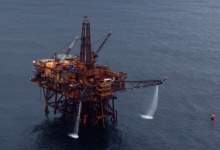

Times are tough for those in the offshore oil and gas industry. The oil price per barrel was cut by more than half in just six months, sending BP profits down by a fifth on the year before and leading CEO Bob Dudley to warn that the industry was entering a “new and challenging phase”.
Among the oil majors, it will be a phase defined by cost-cutting and belt tightening. Shell is to shave $15bn from its forecast expenditure through to 2018, while BP is to slash up to $6bn in 2015. Ambitious exploration projects deemed as opportune in a $100+ per barrel environment no longer appear feasible.
But amid the doom and gloom, there are signs of light. While a low market price hits production of raw crude, it fuels the production of oil based derivatives and processed products, like kerosene and diesel with input costs being significantly lowered. As a result, even the worst hit gain strength in other areas. Chevron, for instance, has taken a hit, with earnings per share down 28% to $1.85. Yet in its downstream operations, earnings rose by a whopping 400% as a result of lower input prices and a drop in US imports boosting its performance domestically. For Chevron, where the balance is firmly in favour of upstream, the huge rise served only to “partially offset” the impact of lower crude prices.
Processors set to profit from price slide
For those further fixed on downstream operations, the damage done by the price drop will be contained, and in some cases bring better fortunes. At state-owned Thai oil company PTT, there is an air of optimism despite a 40% drop in net profits because of the company’s balanced involvement in upstream and downstream. In his presentation to investors, PTT president and chief executive Pailin Chuchottaworn described the new low price era as prompting a “transferring of wealth from upstream to downstream”.
The US Land and Water Conservation Fund (LWCF), a federal environmental programme, recently celebrated its 50th anniversary.
A far firmer benefit is to be seen by those heavily focused on the refinement and processing of crude into petrochemicals. While margins dwindle for those at the top of the supply chain, they thicken for those further down, particularly for those heavily focused on processing and refining.
So just what might the broader impact be on the offshore sector? Well, prior to the price plummet, a trickle of downstream investment was moving upwards.
MOL Group moves upstream
In June 2014, Hungarian petrochemicals and oil company MOL Group announced that it was stepping up its upstream activity, having already grown its portfolio in March with 14 licenses from Wintershell in the North Sea. In a $130m deal, the group purchased stakes in three oil fields from Premier Oil and a number of further exploration licenses.
Announcing the deal, Alexander Dodds, vice president for upstream at MOL Group, said: “Building on our already existing assets in the UK North Sea, this acquisition represents a significant step forward in growing a solid sizeable North Sea portfolio. I am certain that these assets are of considerable quality and will bring further positive results. The synergies gained with this transaction will complement MOL’s ambitions, and help realise the company’s vision of considerable growth of its international portfolio.”
While MOL Group looked to boost its upstream involvement, another company started to make its first moves. In November, multinational chemicals giant INEOS confirmed the long running speculation that it was to enter the offshore oil market when it advertised for a number of senior roles in offshore exploration.
“The job holder will lead the newly created INEOS North Sea offshore oil and gas production business”, reads the advert for the role of CEO of the business unit. In addition to a CEO, the company is also recruiting a number of senior executives, including an operations director, sub-surface manager and engineering manager responsible for “managing the engineering design and planning of wells”.
Operate upstream to fight fluctuation
In the view of ING senior commodity strategist Hamza Khan, the entrance of petrochemical firms and refiners makes strategic sense: “Investment in oil assets can bring stability to European refining margins. You’re not at risk of getting caught short, or being as sensitive to fluctuations in price.”
For MOL Group, the drop in oil prices hit following its investments upstream. However, in its latest statement to investors, it hit an upbeat tone with respect to future operations, describing them as “low-risk”. Announcing that losses had narrowed from £136.5 million to £105.4 million over the year, MOL Group chairman and chief executive, Zsolt Hernadi, said: “2014 proved to be a strong year for MOL Group, notwithstanding that we already felt the effects of the changed oil price environment.”
Downstream, the company saw its best quarterly results for a decade, and Hernandi indicated that this might lead the company to further expand operations: “In terms of acquisitions, we can benefit from the lower oil price environment and we are ready to act if the opportunity arises.” He added: “Due to our integrated business model we can weather the storm and expect robust results even in the changed external environment.”
With a reported $30bn worth of assets up for grabs in the North Sea alone and a number of operators making drastic cuts in expenditure, the balance of power in the sale of offshore assets is moving more and more to the buyer, so those opportunities are likely to arise.
Quite what the future holds for offshore oil, in any area, is far from certain thanks to the current price climate. But each day that prices stay low, profits downstream get bigger. In the short term, that free flow of cheap product lessens incentives to invest further up the chain. But over the long term, companies like MOL and INEOS might see their ever growing cash piles as an opportunity to protect themselves should high prices, and the low margins they bring, return.



